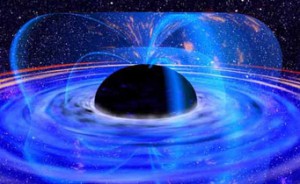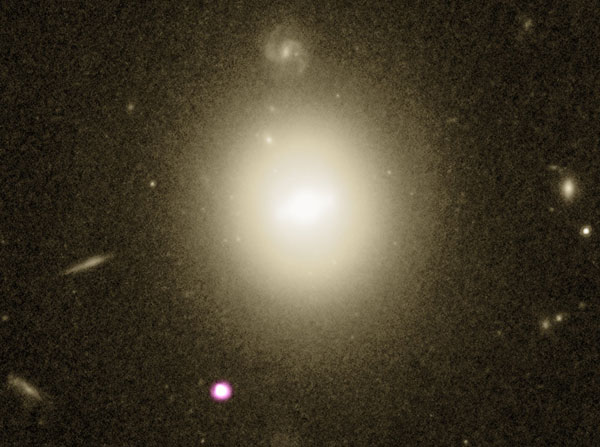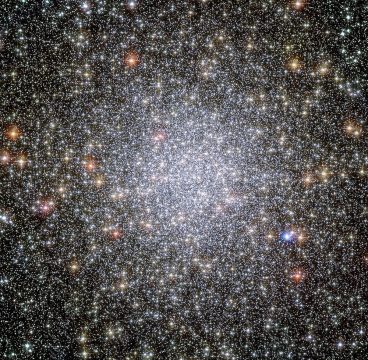A faraway X-ray flare gives more fuel to the concept of intermediate-mass black holes.

XMM Newton / ESA / NASA
A recently discovered X-ray flare from a faraway star cluster might be the telltale sign of a black hole feeding. The team behind these observations says it's the strongest evidence yet for intermediate-class black holes, an elusive member of the black hole family.
Intermediate black holes are predicted from theoretical studies and computer simulations, but they've been tough to spot in the wild. Many astronomers believe they do exist, from an evolutionary perspective. After all, there is evidence for stellar-mass black holes and for supermassive black holes with millions or billions of solar masses in the centers of most large galaxies. Why not a class of black holes in between?
Best Evidence Yet for Intermediate-Mass Black Holes?
In a study that appeared in the June 18th Nature Astronomy, scientists described their observations of an X-ray source in a star cluster that sits at the outskirts of a galaxy more than 700 million light-years away. The X-ray source is known as 3XMM J215022.4−055108. It showed up twice in observations taken between 2006 and 2009 by the XMM-Newton X-ray space telescope. Follow-up observations with the Swift and Chandra space telescopes showed the X-ray source was still there in 2014 and 2016, though emitting at weaker levels.

X-ray: NASA / CXC / UNH / D.Lin et al; Optical: NASA / ESA / STScI
The data as a whole suggest a tidal disruption event. When a star comes within a black hole's reach, the extreme gravitational field tears the star apart star, throwing some of the debris away and swallowing the remainder. As material flies into the black hole, the stuff becomes super-hot – millions of degrees – and emits X-rays. The brightness of the flare faded over the years at a pace that matches simulations of a star being eaten up by a black hole tens of thousands of times the mass of the Sun.
While the X-rays appear to come from a hot gas, its temperature cooled significantly as the flare faded, which agrees with other observations of feeding stellar-mass black holes, the team stated. Comparing the way the flare changed at different X-ray energies with a model of gas accreting onto a black hole gives the black hole’s mass and, the team argues, the clearest evidence for an intermediate-mass black hole.
Astronomers were lucky to spot the flare, says the study's principal investigator . "This is a special case, because the star happened to be so close to this black hole," says Dacheng Lin (University of New Hampshire Space Science Center). He adds that the team continues to go through the archival data in hopes of spotting more flares like this one.
However, more observations will be needed to back up this new work, cautions Bülent Kızıltan (Harvard University), who wasn’t involved in the study. Kızıltan’s primary concern is that the researchers used several models to come to their conclusions. While he notes that the study appears solid, he adds that every layer of complexity in the simulation increases the chances that something else might be responsible for the signal.
Still on the Hunt

NASA / ESA /Hubble Heritage (STScI/AURA) / Hubble Collaboration. Acknowledgment: J. Mack (STScI) and G. Piotto (Univ. of Padova, Italy)
Intermediate-mass black holes are hard to find. Astronomers have looked for intermediate-mass black holes inside "crowded fields" such as star clusters, but Kızıltan notes that it's a bit of a random search. "To be frank," he says, "we don't have any other means to go after this. We can't just look into the void of the universe. How we hope to find them is by their interaction with their environment. It needs to be a crowded field."
Kızıltan led a 2017 Nature study concerning a possible intermediate-mass black hole in the center of the globular cluster 47 Tucanae (NGC 104). In his team’s study, they simulated the black hole’s gravitational signature based on the motions of pulsars speeding around the cluster, coming up with a mass of 2,200 solar masses. In the end, those results didn’t convince everybody either — but the evidence nevertheless seems to be mounting for intermediate-mass black holes.
 1
1









Comments
Bob
July 7, 2018 at 6:18 am
Your first sentence is a grabber -- "... black hole feeding".
You must be logged in to post a comment.
You must be logged in to post a comment.